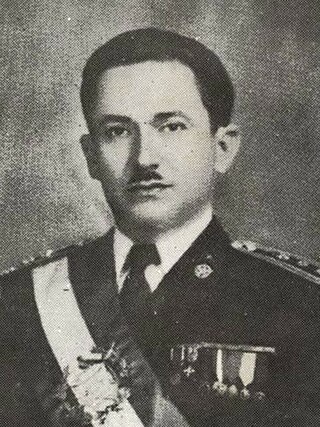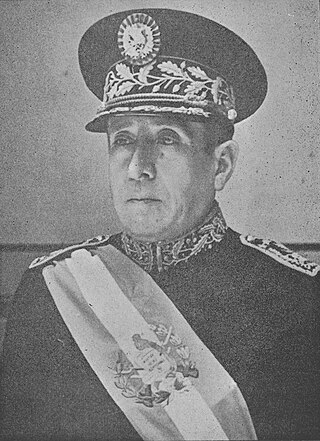Related Research Articles

Juan Jacobo Árbenz Guzmán was a Guatemalan military officer and politician who served as the 25th president of Guatemala. He was Minister of National Defense from 1944 to 1950, before he became the second democratically elected President of Guatemala, from 1951 to 1954. He was a major figure in the ten-year Guatemalan Revolution, which represented some of the few years of representative democracy in Guatemalan history. The landmark program of agrarian reform Árbenz enacted as president was very influential across Latin America.

Carlos Castillo Armas was a Guatemalan military officer and politician who was the 28th president of Guatemala, serving from 1954 to 1957 after taking power in a coup d'état. A member of the right-wing National Liberation Movement (MLN) party, his authoritarian government was closely allied with the United States.

The 1954 Guatemalan coup d'état deposed the democratically elected Guatemalan President Jacobo Árbenz and marked the end of the Guatemalan Revolution. The coup installed the military dictatorship of Carlos Castillo Armas, the first in a series of U.S.-backed authoritarian rulers in Guatemala. The coup was largely the result of a CIA covert operation code-named PBSuccess.

Carlos Enrique Díaz de León was the provisional President of Guatemala from 27 June to 29 June 1954. He was replaced by a military junta led by Elfego Monzón. Carlos Enrique Díaz was previously Chief of the Guatemalan Armed Forces under President Jacobo Árbenz.

José Miguel Ramón Ydígoras Fuentes was a Guatemalan military officer and politician who served as the 32nd president of Guatemala from 1958 to March 1963. He was also the main challenger to Jacobo Árbenz during the 1950 presidential election. Ydígoras previously served as the governor of the province of San Marcos.
Elfego Hernán Monzón Aguirre was a Guatemalan army officer who was President of Guatemala and leader of a military junta from 29 June 1954 to 8 July 1954, during the 1954 Guatemalan coup d'état.

Francisco Javier Arana Castro was a Guatemalan military leader and one of the three members of the revolutionary junta that ruled Guatemala from 20 October 1944 to 15 March 1945 during the early part of the Guatemalan Revolution. A major in the Guatemalan army under the dictator Jorge Ubico, he allied with a progressive faction of the army to topple Ubico's successor Federico Ponce Vaides. He led the three-man junta that oversaw the transition to a democratic government, although he was personally reluctant to allow the elected President Juan José Arévalo to take office in 1945. He served as the Chief of the Armed Forces in the new government until 1949. On 18 July 1949 he was killed in a shootout with supporters of the Arévalo government after he threatened to launch a coup.

Juan Federico Ponce Vaides was the acting President of Guatemala from 4 July 1944 to 20 October 1944. He was overthrown by a popular uprising on 20 October 1944 that began the Guatemalan Revolution.
Operation PBFortune, also known as Operation Fortune, was a covert United States operation to overthrow the democratically elected Guatemalan President Jacobo Árbenz in 1952. The operation was authorized by U.S. President Harry Truman and planned by the Central Intelligence Agency. The United Fruit Company had lobbied intensively for the overthrow because land reform initiated by Árbenz threatened its economic interests. The US also feared that the government of Árbenz was being influenced by communists.
Decree 900, also known as the Agrarian Reform Law, was a Guatemalan land-reform law passed on June 17, 1952, during the Guatemalan Revolution. The law was introduced by President Jacobo Árbenz Guzmán and passed by the Guatemalan Congress. It redistributed unused land greater than 90 hectares in area to local peasants, compensating landowners with government bonds. Land from at most 1,700 estates was redistributed to about 500,000 individuals—one-sixth of the country's population. The goal of the legislation was to move Guatemala's economy from pseudo-feudalism into capitalism. Although in force for only eighteen months, the law had a major effect on the Guatemalan land-reform movement.
Amatitlán is a town, with a population of 98,176, and a municipality in the Guatemala department of Guatemala.
The National Committee of Defense Against Communism was a committee formed on 19 July 1954 in Guatemala by president Carlos Castillo at the request of the United States Central Intelligence Agency. The Committee's primary goal was to fight alleged threats to the government of Guatemala by persons the Committee named as Communist subversives.
Operation PBHistory was a covert operation carried out in Guatemala by the United States Central Intelligence Agency (CIA). It followed Operation PBSuccess, which led to the overthrow of Guatemalan President Jacobo Árbenz in June 1954 and ended the Guatemalan Revolution. PBHistory attempted to use documents left behind by Árbenz's government and by organizations related to the communist Guatemalan Party of Labor to demonstrate that the Guatemalan government had been under the influence of the Soviet Union, and to use those documents to obtain further intelligence that would be useful to US intelligence agencies. It was an effort to justify the overthrow of the elected Guatemalan government in response to the negative international reactions to PBSuccess. The CIA also hoped to improve its intelligence resources about communist parties in Latin America, a subject on which it had little information.
The Revolutionary Action Party was a leftist political party in Guatemala during the ten-year Guatemalan Revolution. Formed in 1945, the party went through a series of mergers and fractures before dissolving in 1954 after the United States-backed coup d'état.
The National Renovation Party was a reformist and progressive political party in Guatemala that was supportive of the government of Jacobo Arbenz. The PRN was founded by a group of the young revolutionaries on 1 July 1944, following the overthrow of dictator Jorge Ubico and the beginning of the Guatemalan Revolution. Its founders included Juan José Orozco Posadas, and Mario Efraín Nájera Farfán. The PRN was known as a “teachers' party”, in contrast to the Popular Liberation Front (FPL), which was seen as a "students' party”. During this period the PRN and the FPL were the largest of the revolutionary parties.
The Anti-Communist University Students Committee, (CEUA) was a rightist, anti-communist organization in Guatemala, which was founded in late 1953, during the last year of the Guatemalan Revolution. Its founders and leaders were Mario Sandoval Alarcon, Lionel Sisniega Otero, Mario Lopez Villatoro, and Eduardo Taracena de la Cerda. Lionel Sisniega Otero was a broadcaster for the clandestine radio station that the liberation movement operated before Jacobo Arbenz Guzmán's resignation, together with Mario Lopez Villatoro and Jose Toron Barrios, who were both killed by the guerrillas in the 1960s. They fought against the government of Arbenz. Headed by a young activist, the group counted 50 members in the capital and a nationwide network of sympathetic students ready to risk arrest. After the coup in 1954 CEUA supported the government of Carlos Castillo Armas.
Presidential elections were held in Guatemala between 17 and 19 December 1944. The October Revolution had overthrown Jorge Ubico, the American-backed dictator, after which a junta composed of Francisco Javier Arana, Jacobo Árbenz and Jorge Toriello took power, and quickly announced presidential elections, as well as elections for a constitutional assembly. The subsequent elections were broadly considered free and fair, although only literate men were given the vote. Unlike in similar historical situations, none of the junta members stood for election. The front-runner was the university professor Juan José Arévalo, nominated by the National Renovation Party. His closest challenger was Adrián Recinos, whose campaign included a number of individuals identified with the Ubico regime. The ballots were tallied on 19 December and Arévalo won in a landslide with 86.25% of the vote, receiving more than four times as many votes as the other candidates combined. The Constitutional Assembly elections took place on 28–30 December, with the United Front of Arevalist Parties winning 50 of the 65 seats.
The period in the history of Guatemala between the coups against Jorge Ubico in 1944 and Jacobo Árbenz in 1954 is known locally as the Revolution. It has also been called the Ten Years of Spring, highlighting the peak years of representative democracy in Guatemala from 1944 until the end of the civil war in 1996. It saw the implementation of social, political, and especially agrarian reforms that were influential across Latin America.
José Manuel Fortuny Arana was an important communist leader in Latin America. He became well known for his friendship with Guatemalan President Jacobo Árbenz, and was one of the main advisers in his government, which lasted from 1951–54. Árbenz was overthrown by a coup engineered by the United States in 1954, an event which drove Fortuny into exile, along with many of his comrades.
The Popular Liberation Front was a reformist Guatemalan political party formed in 1944 largely patronized by the middle class and university students. It was a part of the popular movement that overthrew dictator Jorge Ubico and began the Guatemalan Revolution. During this period, it was one of the two largest Guatemalan parties, the other being the National Renovation Party (PRN) led by teachers.
References
- ↑ Gleijeses 1992, p. 28.
- 1 2 Gleijeses 1992, p. 140.
- 1 2 3 Gleijeses 1992, p. 50.
- ↑ Gleijeses 1992, p. 148.
- ↑ McGehee 1994, pp. 49–81.
- 1 2 Schlesinger & Kinzer 1999, p. 185.
- ↑ Gleijeses 1992, p. 203.
- ↑ Holly 2003, p. 5.
- ↑ Gleijeses 1992, p. 346.